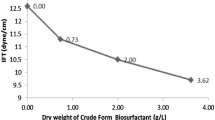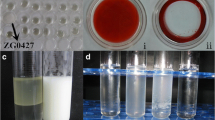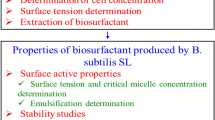Abstract
A biosurfactant (BS) is a surface-active metabolite that is secreted by microbial metabolism, and can be used as a substitute for chemically synthesized surfactants. The first and most critical step to the successful application of BSs is to isolate bacterial strains with strong BS-producing capabilities. In this study, a BS-producing Serratia marcescens ZCF25 was isolated from the sludge of an oil tanker. Through polyphasic characterization using Fourier-transform infrared spectroscopy, thin layer chromatography, and gas chromatography-mass spectrometry, the produced BS was classified as a lipopeptide; it can decrease the water surface tension from 72.0 to 29.50 mN m−1 and has a critical micelle concentration of 220 mg/L. The BS showed a high tolerance over a wide range of pH (2–12), temperature (50–100 °C), and salinity (10–100 g/L). Furthermore, the inoculation of S. marcescens ZCF25 with fracturing flowback fluids could significantly (P < 0.05) reduce the chemical oxygen demand, concentration of alkanes, and concentration of polycyclic aromatic hydrocarbons, with removal efficiencies of 48.9%, 65.57%, and 64%, respectively. This is the first study on the application of BS-producing S. marcescens to treat fracturing flowback fluids. S. marcescens ZCF25 is a promising candidate for use in various industrial and bioremediation applications.

Graphical abstract






Similar content being viewed by others
References
Araujo HWC, Andrade RFS, Montero-Rodriguez D, Rubio-Ribeaux D, Alves da Silva CA, Campos-Takaki GM (2019) Sustainable biosurfactant produced by Serratia marcescens UCP 1549 and its suitability for agricultural and marine bioremediation applications. Microb Cell Factories 18:1–13. https://doi.org/10.1186/s12934-018-1046-0
Bezza FA, Nkhalambayausi Chirwa EM (2015) Biosurfactant from paenibacillus dendritiformis and its application in assisting polycyclic aromatic hydrocarbon (PAH) and motor oil sludge removal from contaminated soil and sand media. Process Saf Environ 98:354–364. https://doi.org/10.1016/j.psep.2015.09.004
Bhargav HS, Shastri SD, Poornav SP, Darshan KM, Nayak MM (2016) Measurement of the zone of inhibition of an antibiotic. IEEE. 10.1109 / IACC.2016.82
Borah D, Agarwal K, Khataniar A, Konwar D, Gogoi SB, Kallel M (2019) A newly isolated strain of Serratia sp. from an oil spillage site of assam shows excellent bioremediation potential. 3 Biotech 9:1–12. https://doi.org/10.1007/s13205-019-1820-7
Chu-Kung AF, Nguyen R, Bozzelli KN, Tirrell M (2010) Chain length dependence of antimicrobial peptide–fatty acid conjugate activity. J Colloid Interf Sci 345:160–167. https://doi.org/10.1016/j.jcis.2009.11.057
Dollinger J, Schacht VJ, Gaus C, Grant S (2018) Effect of surfactant application practices on the vertical transport potential of hydrophobic pesticides in agrosystems. Chemosphere 209:78–87. https://doi.org/10.1016/j.chemosphere.2018.06.078
Elsner M, Hoelzer K (2016) Quantitative survey and structural classification of hydraulic fracturing chemicals reported in unconventional gas production. Environ Sci Technol 50:3290–3314. https://doi.org/10.1021/acs.est.5b02818
Estrada JM, Bhamidimarri R (2016) A review of the issues and treatment options for wastewater from shale gas extraction by hydraulic fracturing. Fuel 182:292–303. https://doi.org/10.1016/j.fuel.2016.05.051
Heinz H, Pramanik C, Heinz O, Ding Y, Mishra RK, Marchon D, FlattcIrin RJ, Estrela-Lopis I, Llop J, Moya S, Ziolo RF (2017) Nanoparticle decoration with surfactants: molecular interactions, assembly, and applications. Surf Sci Rep 72:1–58. https://doi.org/10.1016/j.surfrep.2017.02.001
Helvia WCA, Rosileide FSA, Montero-Rodríguez D, Santos VP, Patricia CVSM, Carlos FBCF, Carlos AAS, Campos-Takaki GM (2017) Biochemical and molecular identification of newly isolated pigmented bacterium and improved production of biosurfactant. Afr J Microbiol Res 11:945–954. https://doi.org/10.5897/ajmr2016.8340
Hu X, Cheng T, Liu J (2018) A novel Serratia sp. ZS6 isolate derived from petroleum sludge secretes biosurfactant and lipase in medium with olive oil as sole carbon source. AMB Express 8:1–12. https://doi.org/10.1186/s13568-018-0698-9
Joy S, Rahman PKSM, Sharma S (2017) Biosurfactant production and concomitant hydrocarbon degradation potentials of bacteria isolated from extreme and hydrocarbon contaminated environments. Chem Eng J 317:232–241. https://doi.org/10.1016/j.cej.2017.02.054
Kadouri DE, Shanks RM (2013) Identification of a methicillin-resistant Staphylococcus aureus inhibitory compound isolated from Serratia marcescens. Res Microbiol 164:821–826. https://doi.org/10.1016/j.resmic.2013.06.002
Kahrilas GA, Blotevogel J, Corrin ER, Borch T (2016) Downhole transformation of the hydraulic fracturing fluid biocide glutaraldehyde: implications for flowback and produced water quality. Environ Sci Technol 50:11414–11423. https://doi.org/10.1021/acs.est.6b02881
Lydon HL, Baccile N, Callaghan B, Marchant R, Mitchell CA, Banat IM (2017) Adjuvant antibiotic activity of acidic sophorolipids with potential for facilitating wound healing. Antimicrob Agents Ch 61:1–9. https://doi.org/10.1128/AAC.02547-16
Manaargadoo-Catin M, Ali-Cherif A, Pougnas JL, Perrin C (2016) Hemolysis by surfactants—a review. Adv Colloid Interfac 228:1–16. https://doi.org/10.1016/j.cis.2015.10.011
McLaughlin MC, Borch T, Blotevogel J (2016) Spills of hydraulic fracturing chemicals on agricultural topsoil: biodegradation, sorption, and co-contaminant interactions. Environ Sci Technol 50:6071–6078. https://doi.org/10.1021/acs.est.6b00240
Morales-Guzmán G, Ferrera-Cerrato R, Rivera-Cruz MDC, Torres-Bustillos LG, Arteaga-Garibay RI, Mendoza-López MR, Esquivel-Cote R, Alarcón A (2017) Diesel degradation by emulsifying bacteria isolated from soils polluted with weathered petroleum hydrocarbons. Appl Soil Ecol 121:127–134. https://doi.org/10.1016/j.apsoil.2017.10.003
Mpelwa M, Tang S, ** L, Hu R (2019) New sulfonate gemini surfactants: synthesis and evaluation for enhanced oil recovery applications. J Disper Sci Technol:1–9. https://doi.org/10.1080/01932691.2019.1652189
Nayarisseri A, Singh P, Singh SK (2018) Screening, isolation and characterization of biosurfactant-producing Bacillus tequilensis strain ANSKLAB04 from brackish river water. Int J Environ Sci Te 16:7103–7112. https://doi.org/10.1007/s13762-018-2089-9
Patel S, Homaei A, Patil S, Daverey A (2019) Microbial biosurfactants for oil spill remediation: pitfalls and potentials. Appl Microbiol Biotechnol 103:27–37. https://doi.org/10.1007/s00253-018-9434-2
Pei G, Zhu Y, Cai X, Shi W, Li H (2017) Surfactant flushing remediation of o-dichlorobenzene and p-dichlorobenzene contaminated soil. Chemosphere 185:1112–1121. https://doi.org/10.1016/j.chemosphere.2017.07.098
Robles-Molina J, Gilbert-Lopez B, Garcia-Reyes JF, Molina-Diaz A (2013) Comparative evaluation of liquid-liquid extraction, solid-phase extraction and solid-phase microextraction for the gas chromatography-mass spectrometry determination of multiclass priority organic contaminants in wastewater. Talanta 117:382–391. https://doi.org/10.1016/j.talanta.2013.09.040
Rosas-Galván SN, Martínez-Morales F, Marquina-Bahena S, Tinoco-Valencia R, Serrano-Carreón L, Bertrand B, León-Rodríguez R, Guzmán-Aparicio J, Alvaréz-Berber L, María R, Trejo-Hernández (2018) Improved production, purification, and characterization of biosurfactants produced by Serratia marcescens SM3 and its isogenic SMRG-5 strain. Biotechnol Appl Biochem 65:690–700. https://doi.org/10.1002/bab.1652
Saimmai A, Udomsilp S, Maneerat S (2013) Production and characterization of biosurfactant from marine bacterium Inquilinus limosus KB3 grown on low-cost raw materials. Ann Microbio 63:1327–1339. https://doi.org/10.1007/s13213-012-0592-7
Santos DK, Rufino RD, Luna JM, Santos VA, Sarubbo LA (2016) Biosurfactants: multifunctional biomolecules of the 21st century international. Int J Mol Sci 17:401. https://doi.org/10.3390/ijms17030401
Sar P, Ghosh A, Scarso A, Saha B (2019) Surfactant for better tomorrow: applied aspect of surfactant aggregates from laboratory to industry. Res Chem Intermediat 45:6021–6041. https://doi.org/10.1007/s11164-019-04017-6
Satpute SK, Kulkarni GR, Banpurkar AG, Banat IM, Mone NS, Patil RH, Cameotra SS (2016) Biosurfactants from Lactobacilli species: properties, challenges and potential biomedical applications. J Basic Microb 56:1140–1158. https://doi.org/10.1002/jobm.201600143
Shen L, Wang W, Li T, Cui Y, Wang B, Yu G, Wang X, Wei D, **ao J, Deng S (2019) Powdered activated coke for COD removal in the advanced treatment of mixed chemical wastewaters and regeneration by fenton oxidation. Chem Eng J 371:631–638. https://doi.org/10.1016/j.cej.2019.04.086
Shrestha N, Chilkoor G, Wilder J, Gadhamshetty V, Stone JJ (2017) Potential water resource impacts of hydraulic fracturing from unconventional oil production in the bakken shale. Water Res 108:1–24. https://doi.org/10.1016/j.watres.2016.11.006
Shuai Y, Zhou H, Mu Q, Zhang D, Zhang N, Tang J, Zhang C (2018) Characterization of a biosurfactant-producing Leclercia sp. B45 with new transcriptional patterns of alkB gene. Ann Microbiol 69:139–150. https://doi.org/10.1007/s13213-018-1409-0
Singh P, Patil Y, Rale V (2019) Biosurfactant production: emerging trends and promising strategies. J Appl Microbiol 126:2–13. https://doi.org/10.1111/jam.14057
Smulek W, Sydow M, Zabielska-Matejuk J, Kaczorek E (2020) Bacteria involved in biodegradation of creosote PAH—a case study of long-term contaminated industrial area. Ecotox Environ Safe 187:109843. https://doi.org/10.1016/j.ecoenv.2019.109843
Spano A, Lagana P, Visalli G, Maugeri TL, Gugliandolo C (2016) In vitro antibiofilm activity of an exopolysaccharide from the marine thermophilic Bacillus licheniformis T14. Curr Microbiol 72:518–528. https://doi.org/10.1007/s00284-015-0981-9
Sun S, Wang Y, Zang T, Wei J, Wu H, Wei C, Qiu G, Li F (2016) A biosurfactant-producing Pseudomonas aeruginosa S5 isolated from coking wastewater and its application for bioremediation of polycyclic aromatic hydrocarbons. Bioresour Technol 281:421–428. https://doi.org/10.1016/j.biortech.2019.02.087
Su C, **ang Z, Liu Y, Zhao X, Sun Y, Li Z, Li L, Chang F, Chen T, Wen X, Zhou Y, Zhao F (2019) Analysis of the genomic sequences and metabolites of Serratia surfactantfaciens sp. nov. YD25(T) that simultaneously produces prodigiosin and serrawettin W2. BMC Genomics 17:1–19. https://doi.org/10.1186/s12864-016-3171-7
Tian W, Yao J, Liu R, Zhu M, Wang F, Wu X, Liu H (2016) Effect of natural and synthetic surfactants on crude oil biodegradation by indigenous strains. Ecotox Environ Safe 129:171–179. https://doi.org/10.1016/j.ecoenv.2016.03.027
Ueno A, Ito Y, Yumoto I, Okuyama H (2007) Isolation and characterization of bacteria from soil contaminated with diesel oil and the possible use of these in autochthonous bioaugmentation. World J Microb Biot 23:1739–1745. https://doi.org/10.1007/s11274-007-9423-6
Zhou H, Huang X, Bu K, Wen F, Zhang D, Zhang C (2019) Fungal proliferation and hydrocarbon removal during biostimulation of oily sludge with high total petroleum hydrocarbon. Environ Sci Pollut R 26:33192–33201. https://doi.org/10.1007/s11356-019-06432-z
Funding
This work was supported by the **nJiang Keli New Technology Development Co., Ltd. (K18-529102-014, K17-529102-004), the National Natural Science Foundation of China (No. 51978189), and the Research Funds of the Guangxi Key Laboratory of Theory and Technology for Environmental Pollution Control (No.1801 K011).
Author information
Authors and Affiliations
Corresponding author
Ethics declarations
Conflict of interest
The authors declare that they have no conflict of interest.
Additional information
Responsible Editor: Diane Purchase
Publisher’s note
Springer Nature remains neutral with regard to jurisdictional claims in published maps and institutional affiliations.
Electronic supplementary material
Rights and permissions
About this article
Cite this article
Huang, Y., Zhou, H., Zheng, G. et al. Isolation and characterization of biosurfactant-producing Serratia marcescens ZCF25 from oil sludge and application to bioremediation. Environ Sci Pollut Res 27, 27762–27772 (2020). https://doi.org/10.1007/s11356-020-09006-6
Received:
Accepted:
Published:
Issue Date:
DOI: https://doi.org/10.1007/s11356-020-09006-6




